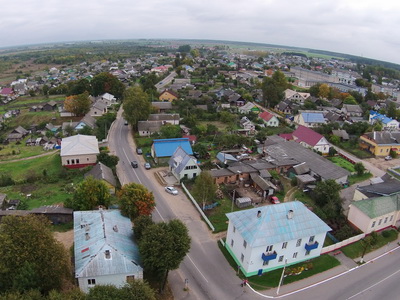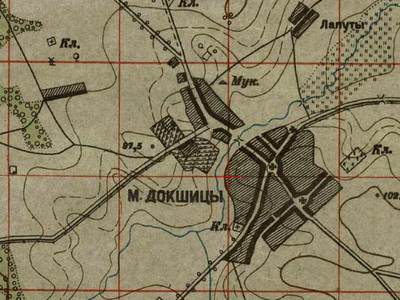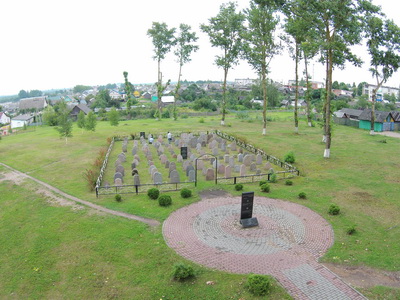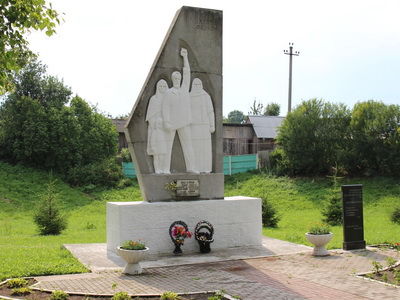About Belarus
Articles dedicated to Belarus history, Belarus politics, Belarus economy, Belarus culture and other issues and Belarus tourist destinations.Dokshitsy, Jewish Dokshitsy
The town of Dokshitsy located near the origin of the Berezina River in Vitebsk region. First mentioned in 1407 as a private village Dokshitsy was divided into different parts that landed into different hands. Since the middle of the 16th century the village was a part of Oshmyany area while in 1621 it was upgraded to a borough.
Its different parts were owned by different noblemen. After the disastrous Northern War of the 1700s the owners restored the catholic cathedral by which a monastery appeared in 1781.
When in Russian Empire Dokshitsy borough became a town and the center of a newly-created Dokshitsy uezd of Minsk Gubernia. In 1796 the town was granted the coat of arms while a year later the locality was cancelled to make Dokshitsy a second-level town of Borisov uezd.

Dokshitsy center air view
In 1800 Dokshitsy, again a borough, numbered 152 households, 1118 residents; a Jewish school and two Uniate churches were operating. During the 1812 war the town was partly torched by the French army.
In 1886 Dokshitsy hosted the office of the area authorities, two churches, a catholic church, a chapel and four inns. By the turn of the 20th century the town had over 4000 residents, two schools and a woolen factory.
Dokshitsy was on the Polish-controlled territory between 1921 and 1939, the status of a town restored. Since 1940 it was the center of Dokshitsy district of BSSR.

Dokshitsy and the area, the map of 1900s
During the Great Patriotic War 10 000 locals were destroyed by the Nazi in the Dokshitsy area. The town itself and the surrounding areas were ruined and three villages were never restored.
Today Dokshitsy is home to 6 600 people who work at several local factories. There are schools, kindergartens, a library and a museum.
Dokshitsy Ghetto
The Dokshitsy ghetto existed from the beginning of the occupation till 29 May 1942. In 1931 the town had about 4000 Jews living in it, the census of 1939 lists 3600 - 75 per cent of the population.
Dokshitsy were occupied by the Nazi troops on 9 July 1941 and liberation came on 2 July 1944. Most of the Jews couldn't or wouldn't evacuate refusing to believe in the atrocities committed by the invaders.
The memorial to ghetto victims was built on the site of a pre-war sandpit. It became the execution ground for the Jewish population of Dokshitsy.
Local administration established in Dokshitsy numbered two dozen locals who were sometimes worse than the SS in maltreating the inmates. However, the town chief appointed by the Nazi managed to give shelter to the Kramer family.

Dokshitsy memorial Jewish Cemetery
After a few random killings the Nazi got down to eliminating the Soviet activists among the Jews. They were tortured for a few days and then driven out of town and shot at an unidentified location.
In July 1941 Jews were ordered to wear a yellow patch on the outerwear. Soon after the occupation a ghetto was established in town - prisoners were given two days for relocation and the size of the luggage was limited by a horse cart. Judenrat was also partially located in the ghetto, around 3000 Jews in total.
The Nazi administration under the fear of death prohibited the Jews to take off yellow patches, leave the ghetto on their own, relocate within the ghetto, use sidewalks, use public transport, be in public or send their kids to school.
The ghetto ran from the synagogue orchard to the main street named after Kostiushko and included several alleys limited by Gorky Street, Sovetskaya, Internatsionalnaya and the Berezina River. Irregular meals of 300 grams of bread per person forced the Jewish craftsmen to smuggle their belongings out for a food swap.
Right until the complete extermination Jews were forced to take hard and dirty jobs. Excessive strain, zero healthcare and torture killed many prisoners even before the ghetto close-down. The smallest wrongdoings were severely punished. The polizei members were humiliating the prisoners and robbed them openly all the way through. The Judenrat members did their best to help the inmates - they even opened a policlinics and a synagogue.
The first pogrom occurred in March 1942 run by the local police force. A part of Jews was shot which forced the survivors to build hideouts for the next trouble. The next Aktion - Nazi term used for mass killings - claimed 350 Jews including Rabbi Sheinin who didn't hide (the executioners found him praying indoors). The survivors were divided into those with the worker's certificate and those without - the latter were shot. On 29 May 1942 the Dokshitsy Ghetto was eventually closed down with the remaining 2653 inmates murdered.
The latter execution lasted 17 days because the Nazi were trying very hard to find the shelters. Groups of survivors were found here and there and killed.

Dokshitsy Genocide Steeple
The memorial Jewish cemetery in Dokshitsy in Mayakovsky Street was built on the site of the formerly flattened Jewish graveyard. It was one of the mass killing grounds of the Jews. Macevas scattered around the town were brought here while many still remain buried.
Some Jews from Dokshitsy managed to escape into the forests where they joined partisans while others were hidden by the local families who put their own lives at stake.
On 18 May 1968 a public garden was put up at the execution site and a steeple installed. Genocide memorial was placed at the old Jewish cemetery.
Dokshitsy in Northern Belarus...
Posted by Minsk Guide on Thursday, 15 October 2015
If you wish to visit Dokshitsy to trace your family roots or just have a tour to the ancestral grounds, I will be happy to be your tour guide in Belarus!
|
|
Featured
Applying at their local Belarus Consulate, the citizens of migration-secure states (e.g. the USA, Canada, Japan and others) can obtain a short-term...
The form of application for a visa to Belarus has become digital and you can save and send it as a PDF file. It is only a 2-page document that is available...
Quite a number of things, as a matter of fact. Let’s examine a typical case from my travel agent’s past with a traveler landing in Minsk Airport (MSQ) and applying for a visa...
People, who want to travel to Belarus to see a friend, take care of the grave of a relative, take part in the court hearings, etc. need to apply for a private visa...
This article covers field family research in Belarus that in most cases comes after dealing with the State archives of Belarus and genealogical research.
A plastic card is a fine thing, no doubt, but there have been a number of cases when the ATM displayed ERROR, or required a PIN code...
While most tourists agree that Belarus is not the country for grand shopping, there are still some things that can be brought back as souvenirs...
